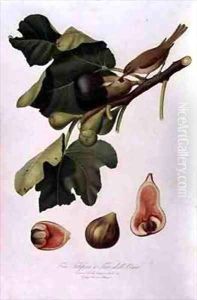Giorgio Gallesio Paintings
Giorgio Gallesio was an Italian botanist, horticulturist, and agronomist, renowned for his work in pomology, the study of fruit cultivation. Born in the town of Finalborgo within the Republic of Genoa (present-day Finale Ligure, Liguria, Italy) on April 2, 1772, Gallesio embarked on a career that would span various disciplines and interests, reflecting the intellectual curiosity characteristic of the Enlightenment period.
Initially, Gallesio pursued a legal career, which was common for individuals of his social standing at the time. His early professional endeavors led him to hold positions within the administration of the Napoleonic Kingdom of Italy. However, his passion for the natural sciences, particularly botany, would eventually prevail, leading him to devote his life to the study of plants.
In the realm of botany, Gallesio is best remembered for his monumental work 'Pomona Italiana,' which he began publishing in 1817. This extensive treatise on Italian fruit trees was one of the first attempts to systematically categorize and illustrate the fruit varieties of Italy. The work is notable for its detailed descriptions and high-quality illustrations, which were often based on Gallesio's own watercolors. 'Pomona Italiana' is considered a pioneering text in pomology, as it contributed to the understanding of fruit tree cultivation, propagation, and the importance of genetic diversity within orchards.
Gallesio's interests, however, were not limited to pomology. He conducted extensive studies on plant hybridization and was among the first to recognize the significance of cross-pollination as a mechanism for producing new plant varieties. His observations and experiments with citrus fruits, in particular, added to the knowledge of hybridization processes long before the modern science of genetics was established.
Gallesio's contributions to agriculture and the understanding of plant life were recognized by his contemporaries. He was appointed to various scientific societies and received accolades for his work. His legacy is reflected in the continued relevance of his research, especially in 'Pomona Italiana,' which remains a valuable resource for pomologists and horticulturists to this day.
Giorgio Gallesio's death on November 8, 1839, in Florence marked the end of a career that had a lasting impact on the field of agricultural science in Italy and beyond. His dedication to the natural world and his meticulous approach to the study of plants paved the way for future generations of scientists interested in the diversity and cultivation of fruit.
